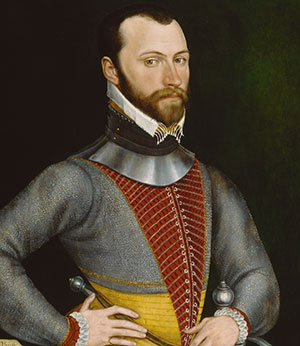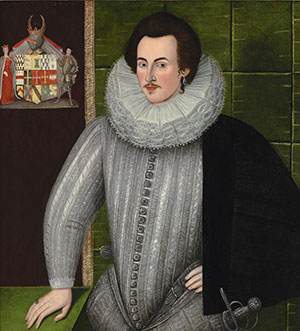‘A mere Irish man, but good Protestant’: Sir Francis Shane, 1540–1614
Published in Features, Issue 2 (March/April 2017), Volume 25An assessment of the character and career of an atypical advocate of English rule in late Tudor and early Stuart Ireland
By Joseph Mannion
Intriguingly described by seventeenth-century churchman and historian Thomas Fuller as ‘a mere [pure] Irish man, but good Protestant’, Sir Francis Shane’s life and career in late Tudor and early Stuart Ireland is fascinating in the context of his Gaelic Irish background and English-style Pale upbringing. His father, Nicholas Shane, belonged to an Anglicised branch of the O’Farrells of the Annaly, later shired as County Longford, who had adopted the ancestral name Shane (Ir. Séan) in place of O’Farrell during the process of Anglicisation. His mother, Margaret Bathe, who was described as ‘an Irish woman’, was in all likelihood of Pale English extraction. Born in 1540, Shane’s formative years were spent at Ballymore Loughsewdy in the mid-Tudor frontier region of Rathconrath barony, which became part of the newly erected county of Westmeath in 1542.
Following the death of her first husband in 1557, Margaret Bathe married Thomas le Strange (1518–90), an English military man from Hunstanton in Norfolk who served as henchman to Henry VIII and Edward VI and was then sub-constable of Athlone Castle. In 1559 he was appointed sheriff of County Westmeath, which would have afforded Shane the opportunity in late adolescence to observe his English-born stepfather’s active involvement in the martial and civil government of the local shire. Some years later, Shane’s youngest sister Alice married a County Meath lawyer named Thomas Dillon, who would serve as chief justice of Connacht from 1577 to 1606. Like Shane and le Strange, Dillon embarked on a campaign of land acquisition in Connacht that spanned his long service with the provincial presidency, established in 1569 under the auspices of the lord deputy, Sir Henry Sidney.
Twenty-four years in Connacht
Shane’s career in Connacht commenced in 1572, most likely in the service of le Strange, who was appointed constable of Roscommon Castle by Sidney in 1569. His service is unlikely to have been restricted to martial matters, however, since his familiarity with the language and customs of the Irish people would have been a crucial asset to his English stepfather in his public and private pursuits. By 1583 Shane had become involved in the local government of his newly adopted county of Galway, where he served as sheriff of the shire that year. In 1584 he and his wife Mary received a pardon for probable wrongdoings while he held the shrievalty, being landowners and residents at Ballygar in north Galway at the time.
A few miles north-east of Ballygar stood le Strange’s castle at Athleague. He was knighted by the lord deputy, Sir John Perrot, and made a member of the Irish privy council in summer 1584. Le Strange was also elected knight of the shire for County Galway in 1585, as was his stepson and near neighbour Francis Shane. In this prestigious capacity, le Strange and Shane attended Perrot’s parliament in Dublin in April that year. In August they featured with Dillon and other new arrivals (mostly associated with the presidency) among the local lords and foremost landowners in the province when the second composition of Connacht was agreed. Being well-established crown functionaries at the time, this enterprising triumvirate of Anglophiles—an Englishman, a Palesman and an Irishman—would give loyal service to the English state in the western region and beyond for the remainder of their lives.
‘Great zeal in religion’
Shane’s enthusiasm for the reformed church is first noticed in a letter of recommendation by the president of Connacht, Sir Richard Bingham, in 1593. In the decade that followed, other prominent government officials, such as Adam Loftus, Sir Henry Wallop, Sir George Carew, Sir Richard Wingfield and Lord Deputy Mountjoy, would echo Bingham’s approbation of the depth and sincerity of his religious beliefs. The singularly most enlightening endorsement, however, came in 1601 from Thomas Jones, bishop of Meath, who informed English secretary of state Sir Robert Cecil that Shane was ‘in religion very zealous and constant, the only assistant I find in the County [Westmeath] where he dwells’.

Above: Down Survey map of Rathconrath barony in County Westmeath, showing Ballymore town and nearby locations encircled, where Sir Francis Shane held lands and dwellings in the course of his lifetime. (TCD)
Shane gave a practical expression of his commitment to the Protestant faith by rendering crucial financial support to the newly established Trinity College, Dublin, in the early 1590s. He was among the earliest to respond to Lord Deputy Fitzwilliam’s wide-ranging appeal for funds, bestowing in the first instance £100 towards the erection of the college buildings. This was supplemented by a pledge of £20 a year to the college for the remainder of his life, with a further £10 a year to be contributed forever for the maintenance of a scholar. It was in the context of his support for the embryonic institution that Fuller wrote: ‘Sir Francis Shane, a mere Irish man, but good Protestant, was a principal benefactor, and kept this infant-foundation from being strangled in the birth thereof’. Moreover, Shane’s remarkable patronage led to his inclusion by Fuller in a select assemblage of the college’s founders and funders, comprising Henry Usher, Queen Elizabeth, Lord Burghley, Sir William Fitzwilliam, Luke Challoner, the mayor and aldermen of Dublin, Adam Loftus, Sir Warham St Leger, the earl of Essex and King James I—esteemed company indeed in which to find ‘a mere Irish man’ of late Tudor and early Stuart Ireland!
‘Our well-beloved subject’

Above: Sir Richard Bingham—commended Sir Francis Shane for his ‘great zeal in Religion’ and exemplary service ‘to the State’ in 1593. (NPG)
‘A meet instrument’

Above: Lord Deputy Sir Charles Blount, Lord Mountjoy, who knighted Sir Francis Shane for his ‘very special service’ in Christ Church Cathedral on 6 April 1600. (Weiss Gallery, London)
Royal reception
Profoundly impressed by Shane’s service, the president of Munster, Sir George Carew, became the latest in an impressive series of English-born government officials to put pen to paper, unreservedly extolling his loyalty and utility to the crown. The letter to Secretary Cecil focuses on Shane’s commendable personal traits and his distraught circumstances resulting from the war. About the same time, Shane indicated to Cecil that he wished to repair to the queen to seek assistance with his financial situation. His request was soon granted, and following his journey to court in April 1601 he was accorded a gracious reception, far exceeding his expectations, by Queen Elizabeth. She took pity on his distressed state and was pleased to grant him whatever Cecil would consider fit for the restoration of his ruined estate.
A matter of mutual concern to the queen and Shane was the continued existence of the Franciscan friary at Multifarnham in County Westmeath. Whether or not the issue arose during Shane’s royal audience is uncertain, but correspondence with Cecil reveals an extended campaign on his part for the destruction of this ‘den of scorpions’ and ‘nursery of all mischievous practices’. Possibly stemming from this, the queen had written to the lord deputy and council in June 1600, censuring the bishop of Meath for having allowed the friary to stand untouched, a place where Counter-Reformation Jesuits assembled and where the great rebellion was deemed to have been planned. Unsurprisingly in the circumstances, at the beginning of October 1601 Shane plundered and burned Multifarnham friary at the behest of Bishop Thomas Jones.
Elder statesman
Shane is not known to have played any part in the decisive English victory at Kinsale in 1601, but continued to serve in the royal army until September 1603. For the previous decade he had enjoyed the powerful patronage of the Cecils at court, but inexplicably had fallen out of favour with Robert Cecil by June that year. Feeling ‘desolate and friendless’ as a consequence, he wrote to Sir Michael Hickes, former secretary to Burghley and close friend to Cecil, to intercede on his behalf, sending Hickes a harp he had promised some years earlier, and ‘a fotcloth nag’ (or caparisoned horse) as gratuities. Regardless of his expected intervention on Shane’s behalf, there is nothing to indicate that there was an early resolution of the matter.
Shane’s loyalty to the crown didn’t falter, however, and following the appointment of Richard Burke, fourth earl of Clanrickard, as president of Connacht in July 1604, he was nominated to serve with him as one of the justices and commissioners for the civil government of the province in January 1605. His last recorded commission related to the investigation of claims of freedom from payment of composition rent in Connacht in 1611 and 1612 in his advancing old age.
On foot of the foregoing evidence, which portrays Shane’s lengthy service as entirely unblemished, we are firmly cautioned against the casual acceptance of rigid historical distinctions between Old English, New English and Gaelic Irish elements of society in Tudor and Stuart Ireland. Shane’s unwavering allegiance to the crown transcends the social and ethnic divisions of the period, challenges traditional perceptions of contemporary Irish society and confirms that this ‘mere Irish man’ was (in the well-informed words of Sir Geoffrey Fenton) ‘a faithful and assured instrument … always to the State’.
Joseph Mannion is an independent scholar and former school headmaster.
Read More:
Knighthood conferred
FURTHER READING
N. Canny, Making Ireland British, 1580–1650 (Oxford, 2001).
B. Cunningham, Clanricard and Thomond, 1540–1640: provincial politics and society transformed (Dublin, 2012).
J. Mannion, ‘“As trew Englishe as any man borne in Myddlesex”: Sir Francis Shane, 1540–1614’, in C. Maginn & G. Power (eds), Frontiers, states and identity in early modern Ireland and beyond: essays in honour of Steven G. Ellis (Dublin, 2016).
T.O. Ranger, ‘Richard Boyle and the making of an Irish fortune, 1588–1614’, Irish Historical Studies 10 (39) (March 1957), 257–97.
















